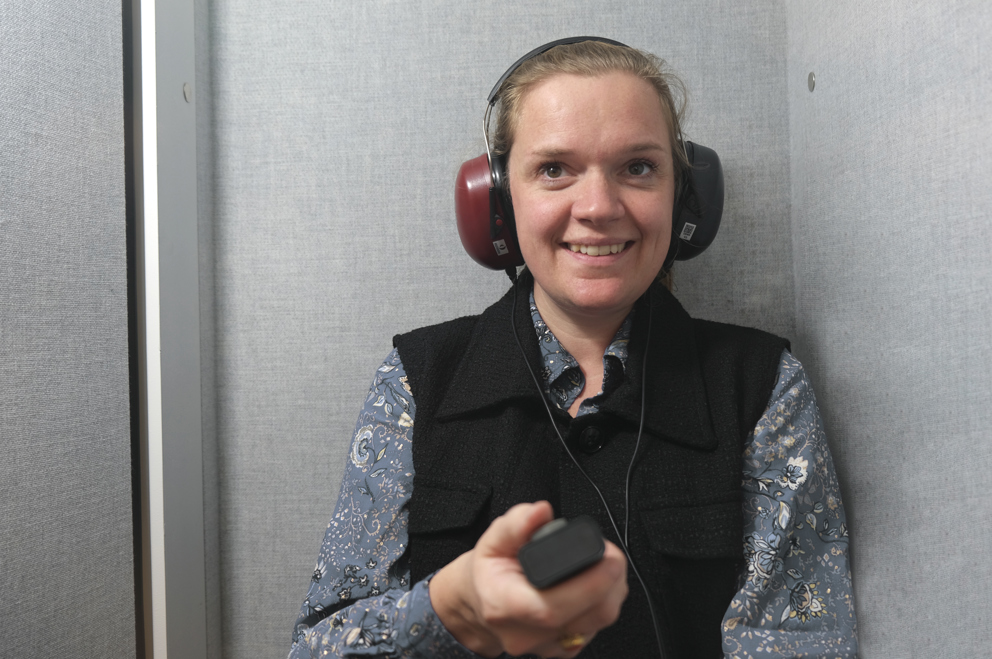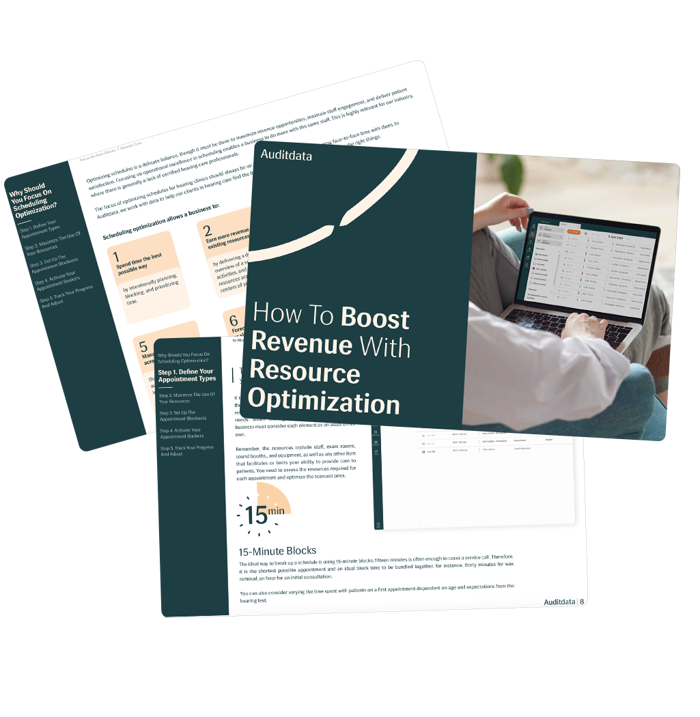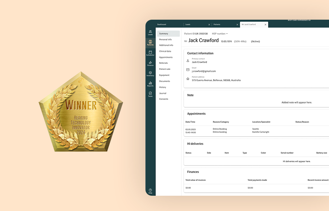
We often talk about increasing productivity in the hearing clinic, but what does that really mean and why does it matter? Productivity is a metric that helps you understand:
- The measure of work effectiveness
- The amount of labor needed to complete a job
- When and how your business needs to adjust to achieve better results
Productivity allows staff to get more high-quality work done in less time. This blog will explain why understanding, calculating, and boosting productivity is essential, and provide tips on how to accomplish this.
A hearing care professional or staff’s productivity is the amount of value generated by an individual within a specific period. Internal and external factors influence productivity, including:
- The economy
- Competition
- Workflow
- Processes
- Staff engagement
- …and more
Understanding and calculating productivity can help you understand and optimize your workforce and be more adaptable when productivity changes.
Management consultant Peter Drucker has famously said: “If you can’t measure it, you can’t improve it”. This is certainly true from a productivity standpoint.
Staff productivity is an important thing for your care clinic or clinic to measure. Understanding productivity will help you adapt and adjust in ways that will benefit your business and clinical care.
The formula to calculate productivity is:
Productivity = total output/total input
As an example, suppose a company produces hearing aids. In one month, they make more than 200,000 hearing aids, with 40 staff working 18 days, 9 hours per day, for 6 months.
To calculate your total input:
Input = 40 (# of staff) x 9 (# of hours of work per day) x 6 (# of months) x 18 (# of days worked in a month).
That’s 38,880.
Productivity = 200,000 / 38,880 = 5.14
That means the company produced 5.14 hearing aids every hour.
Now, suppose that company hired an Operations Manager to optimize processes and workflows. This leads to a more significant increase in the number of hearing aids produced (270,000) but maintains the same amount of effort.
As a result of this one change (a manager to optimize processes and workflow), the company’s output increased to 6.8 HA per hour.
That’s an improvement of 1.66 (32%) in productivity based on that one change. You can see how having the data – and making just one adjustment – can significantly improve the productivity numbers and total output.
Increasingly, hearing care clinics and clinics are relying on tech solutions – rather than gut instinct – to track key metrics, such as productivity. Using a practice management software like Auditdata Manage allows care clinics to easily compile, review, and assess reports on numerous metrics, including productivity. Using this intuitive software allows care clinics to easily track and measure productivity by care clinic location and staff.
Why Should Care Clinics Track Productivity?

Your hearing care clinic should track productivity to:
Manage your business better – A solid understanding of your care clinic’s productivity levels results in many benefits. More data allows care clinic owners to:
- Make more informed decisions about critical things like staffing, scheduling, equipment utilization, etc.
- Help identify areas of concern (e.g., underperforming staff members, an inefficient scheduling model, overscheduled hearing care professionals, etc.)
Auditdata’s practice management software, Manage, helps care clinic and clinic owners track productivity by location and staff, spot trends, and adjust, as necessary.
Track productivity changes – If there’s a drop in productivity, it will negatively impact your bottom line. Look for any productivity changes and determine what’s causing them:
- Is an audiologist overworked and burnt out, leading to less productive efforts in the care clinic?
- Have you lost customers and need to generate more leads to fill your schedule?
Once you identify any changes and determine their cause, you’re able to act quickly to improve the situation.
Optimize your workflows. Calculating productivity will help your care clinic understand your current workforce and workflows, providing critical information about whether you need to make any adjustments.
This is important data to see if you need to adjust work schedules, organizational structure, operational costs, staff performance, and/or any other factors that contribute to your care clinic’s success.
Boost profitability and improve your bottom line – Analyzing productivity allows you to adjust and optimize staff, processes, or workflows to maximize performance and, ultimately, your bottom line.
This effort helps ensure your care clinic is in the best position to increase appointments, sales, and profits.
Productivity Factors In Hearing Care Clinics

Consider these factors when looking at productivity in your care clinic:
Complexity of service. Some services (like ear wax removal) are quick and can be completed in 15 minutes. Other appointments (such as an initial appointment and hearing test) may take a full hour. Consider the complexity of the service and the length of the appointment when calculating productivity:
- If Audiologist A performs 32 ear wax removals in a 9-hour day, and Audiologist B performs 8 initial appointments in the same timeframe, you cannot assume that Audiologist A was more productive because they completed more appointments.
- Consider other factors (e.g., a patient’s age, the severity of their hearing loss, their communication difficulties), that may impact the length of the appointment.
Auditdata offers this helpful guide to optimize scheduling so you can boost key performance metrics.
Free Guide
How To Boost Revenue With Resource Optimization
Did you know that optimizing your schedules can be one of the most efficient ways to maximize your revenue? We have designed this guide to assist retail audiology businesses in optimising their schedules for success. Following five steps will help organise a scheduling strategy that maximises revenue, delivers opportunities and visualises all staff and resource availability across an enterprise.

Space and equipment. Audiologists need specific spaces (e.g., exam rooms, sound suites, etc.) and equipment (e.g., testing and fitting tools) for appointments. The availability of space and equipment impacts (or potentially limits) patient flow through the care clinic or clinic.
- Ensure you have enough space and equipment for your hearing care providers to maximize productivity each day.
- Use a tool like Auditdata Manage to schedule rooms and equipment, as well as audiologists’ time.
- Use Manage to book staff, rooms, and equipment in separate, flexible blocks, which provides maximum flexibility.
- Adjust times – down to the minute – in Manage.
In other words, if Audiologist A needs to meet with a customer for a full hour, but only needs to use the audiometer for 15 minutes within that appointment, the scheduler can book the audiologist for the full hour and the equipment for just 15 minutes. Then, Audiologist B can use the equipment for a different block of time during that hour.
These seemingly small details add up to increased productivity and efficiency.
Staffing and capabilities. Does your care clinic use support staff efficiently? Can busy audiologists offload some of their tasks to administrative staff? Utilizing support staff for multiple roles (e.g., a receptionist answers the phones and completes other tasks) positively impacts productivity. When assistants take on more responsibilities, the hearing care professionals can focus on seeing more customers.
Not all hours are the same. Factor in on-duty hours, staff leave (e.g., vacation, sick days, personal days), and non-clinical hours (e.g., staff meetings, paperwork), which all impact time available for customer or patient care. When audiologists are assigned duties other than customer appointments (e.g., administrative tasks, research, mentoring), that can impact productivity numbers. While this time is productive (and necessary) in terms of care clinic operations, it does not generate direct patient care hours.
Measuring Productivity And Effectiveness

Productivity measures output over time, but effectiveness indicates how well a task is completed.
For example, someone on your marketing team might develop three marketing campaigns in one week while their colleague might create 20 marketing campaigns in the same period. On the surface, the colleague who created 20 campaigns appears to be more productive, with a much higher output.
But perhaps the three campaigns included in-depth research, focus group testing, high-quality design, thoughtful messaging, and a curated list of targeted prospects, all of which took considerable time to compile. And what if the 20 marketing campaigns were sloppy, careless, and off brand? There may be more campaigns created, but they’re not high-quality.
Therefore, to understand how strong your workforce is, you need to consider both effectiveness and productivity.
Audiology care clinics and clinics can use Auditdata Discover, an analytics platform, to boost transparency and get key metrics and insights, including information about productivity and effectiveness. This data empowers care clinic leaders, helping them make more informed, fact-based business decisions that will drive business growth and improve care.
How To Improve Productivity

Use technology to get valuable insights. An integrated, user-friendly practice management software, like Auditdata’s Manage, is invaluable in tracking productivity and other key metrics for your clinic.
Manage provides insights around how your staff are using their time, how many customers they see in a day, the type and length of each appointment, and more. Using that data, you can spot and address any issues, such as inefficient scheduling or problematic workflows.
Engage staff. Engagement and productivity are closely linked. If you want productive staff, work continuously to boost employee engagement, as research shows that engaged staff are up to 17% more productive than their peers.
Show your appreciation for your staff, make them feel valued, and respect their opinions and contributions. It also helps to provide an incentive structure that motivates them to meet certain metrics, including a pre-determined productivity level.
Set clear goals for each employee, position, and department. One of the best ways to measure the productivity of individual staff is to see how they’re measuring up against the goals you’ve set for them.
Only about half of workers say they know what is expected of them at work. Set clear objectives related to each employee’s (and each department’s) output and efficiency.
Recognize that metrics will be different across roles and, therefore, the ways you measure productivity will also differ. Offer bonuses or incentives for staff that meet their goals and build this into your clinic’s salary structure. These clear goals will motivate them and help you monitor if (and when) people are falling short.
Have honest conversations with your team. One great way to measure staff’ productivity is to talk to them about it. Your staff are the ones doing the work, so they’ll have plenty of insights into how your clinic (and staff) can be more efficient and effective.
- Are there certain things that they think are time wasters?
- Are there tasks they feel take more time than they should?
Your staff will appreciate that you’re asking for their input, and you’ll get valuable information on what’s working well and what isn’t. This exercise will also help with employee engagement efforts.
Do regular productivity audits. Schedule time to review productivity metrics on a regular basis, ideally quarterly. Auditdata Manage allows clinic owners to easily review reports, which helps clinic owners assess productivity numbers.
Look objectively at what’s working, as well as potential barriers. Do this more often than once a year, so you’ll be able to identify (and fix) any issues promptly.
Final Thoughts
Tracking productivity requires collecting and analyzing significant data regularly, but with a Practice Management Software like Manage, this effort is quick, easy and accurate. Once you put the right systems in place, you can easily detect changes in productivity and adjust, as needed, to maximize success.
Contact Us For More Information
Auditdata helps hearing care providers improve clinical care and drive their business performance and growth. We offer data-driven, connected solutions to help you take your audiology business to the next level.

Other Blogs You Might Enjoy:

How Using Data Can Have a Positive Impact On Business Decisions And Long-Term Growth
In audiology shops and clinics, diagnostic errors may occur due to assumptions. Using data effectively can drive business decisions and long-term growth.

7 Critical Actions to Maximize Success in Your Hearing Care Business
Owning a hearing health clinic can be extremely rewarding. This post will spotlight seven critical actions you can take to maximize success.

How Poor Communication Destroys Your Hearing Loss Sales Efforts
Hearing loss is one of the most common chronic conditions experienced by older adults. The lack of accurate information and stigmatizing mindsets surrounding ear diseases and hearing loss often limit access to care.
Don't Miss Out On the Latest Insights On Audiology
Sign up today to receive exciting updates, tips, and the latest newsletters from Auditdata.
Resources
⭐️ FREE Guide: How to boost revenue with resource optimization
⭐️ Auditdata's Practice Management Software: Manage
⭐️ Auditdata's Add-on | BI analytics tool: Discover
⭐️ Blog: Setting effective objectives and KPIs for different staff types in hearing care
⭐️ Why is Employee Engagement Important? 14 Benefits Backed By Research
⭐️ Do Employees Really Know What's Expected of Them?





